Summer 2025
A Destiny Like No Other
Anna Kingsley was an African princess before being enslaved and later becoming a slaveholder. The Park Service and her descendants have worked to preserve her story.
Whenever Zephaniah Kingsley Jr., a prominent slave trader, left his plantation on Florida’s Fort George Island, he delegated supervision of the cotton-and-citrus-growing operation to his young wife Anna. In addition to regular duties that included managing food preparation and treating illnesses and injuries, Anna would direct the work of her husband’s dozens of enslaved workers and the few who were her own property. “She had authority over all in the plantation when Zephaniah was not there,” said Daniel Schafer, a historian. “She would have been a superior figure.”
That sort of arrangement would not have been uncommon in the early-19th-century American South. But Anna was not just any planter’s wife: She was an African woman, and just a few years earlier, she had been enslaved herself.
Born Anta Madjiguène Ndiaye into a royal family of today’s Senegal, she suffered unspeakable hardship, from her capture as a child to the brutal Middle Passage across the Atlantic and years of servitude at the mercy of a man nearly 30 years her senior who impregnated her when she was just 13 years old. But thanks to her resiliency and exceptional capacity for adaptation — as well as relatively flexible rules around racial relations in Spanish-controlled Florida — Anna Kingsley attained a prominent position in the New World.

Peri Frances-Betsch and Emanuel Kingsley, two descendants of Anna and Zephaniah Kingsley, on the plantation grounds during the Kingsley Heritage Celebration in 2006.
NPS“Although I’m sure that’s not the life that she predicted or that she imagined, in some ways, she did kind of live the same type of life that she was born and trained into,” said Peri Frances-Betsch, one of her descendants. “If you just look at the broad strokes and take out, you know, a sizable amount of the trauma.”
These days, visitors can tour the Kingsley Plantation at Timucuan Ecological and Historic Preserve, a national park site located some 25 miles outside of Jacksonville. In addition to Zephaniah’s residence, the plantation includes Anna’s house and the remains of the slave quarters, arranged in a half circle perhaps inspired by the structure of the African villages familiar to Anna. But her legacy extends well beyond Timucuan. Many of Anna’s descendants have left their own mark as scholars, successful businesspeople and park advocates. And as her story has become more fully known through Schafer’s extensive research, her relatives in Florida, the Dominican Republic and Senegal not only learned more about her but also about each other. “It did work out that way, and it has been a great pleasure for me,” Schafer said.
Schafer, then a new history professor at the fledgling University of North Florida, first visited the plantation in 1975 upon the suggestion of a friend. The little he heard that day about Anna and Zephaniah Kingsley was enough to spark a lifelong pursuit. “I was just stunned by what an intriguing story it was, how important a story it was,” he said.
Over the next several decades, he chased historical documents and bits of oral history from North America to Senegal and the Caribbean by way of Great Britain and Denmark. He first published a biography of Anna in 2003 and followed that up with a biography of Zephaniah 10 years later. Along the way, he met her relatives in Senegal, many of whom were thrilled to discover she had survived and — to some degree — thrived in America.

Secrets of the Tombs
Archaeologists at the Kingsley Plantation in Florida shed light on the slaves who lived, worked and died there 200 years ago.
See more ›Anta was her father’s favorite and was a “happy and pampered child,” according to oral history that Schafer recorded after corresponding with descendants of the Ndiaye family. As the daughter of the future ruler of the Kingdom of Jolof, she could have expected an arranged marriage to an older notable and a life within a polygamous household. But in early 1806, shortly after she turned 13, she was abducted by slave hunters.
It’s unclear whether Zephaniah, a regular traveler to Africa, first laid eyes on Anta on Gorée, an island near the West African coast where captives waited before their perilous journey to America, but he formally purchased her in Havana later that year and brought her, along with two other enslaved women, to his Laurel Grove plantation, south of today’s Jacksonville. She was pregnant with their son George when she arrived and would bear three more of their children.
Anta was one of several enslaved women Zephaniah considered his co-wives, but he seemed especially fond of her and considered her his principal wife. In March 1811, he signed manumission papers for the woman he called Anna, recognizing “the truth and fidelity with which she has served me,” releasing her — and their young children — from slavery.
Anna moved to her own farm across the river, taking with her the 12 enslaved people she owned by then. But before long, the area was under attack by militias, Seminoles and marauders during the short-lived and confusing Patriot War, the result of a challenge to Spanish rule in Florida. Anna set fire to the Laurel Grove plantation and her own farm to prevent them from being taken over by the rebels. She “worked like a heroine,” a Spanish officer wrote in his report, and later received a 350-acre land grant in compensation and as a reward for her bravery.
A ONE-WOMAN CRUSADE
Soon, the Kingsleys moved to Fort George Island, where Anna would stay more than two decades — the longest stretch in her itinerant life. She helped beautify the plantation by designing a palm-tree-lined avenue that visitors use to this day. Her children received a high-quality education. “Tutors have attended them from infancy; the girls have been taught music and dancing, the modern languages and polite literature,” a traveler reported. Anna also struck up a friendship with Susan L’Engle, another planter’s wife who was white. According to a book written by L’Engle’s great-granddaughter, the two often “went off together to the princess’ rooms and talked and drank cold tea together.”
But after the United States annexed Florida in 1821, local authorities placed increasingly harsh restrictions on free Black people. In the late 1830s, Zephaniah decided to relocate Anna, his two sons and some of their enslaved workers to the Dominican Republic, then under of the control of Haiti, where slavery had been abolished. The Fort George plantation was sold to Zephaniah’s nephew in 1839.
Emanuel Kingsley, a descendant of Anna and Zephaniah who grew up in the Dominican Republic, said he was told at a young age that Anna wore long white dresses, carried a pouch with money around her wrist and was attended by young servants. “The family always knew and stressed that she was a princess,” he said.
After Zephaniah died in 1843, his sister contested his will in court on the basis that he left much of his wealth to his Black family. Anna felt compelled to move back to Florida and defend what was theirs, and remarkably, the judge ruled in her favor. “I wonder if that had anything to do with her being like, ‘Oh, you’re going to take my money, my land from me? You clearly don’t know who it is that you’re dealing with,’” Frances-Betsch said.
As late as 1860, Anna still owned four humans, aged about 9 to 17. “I would love to have had somebody who was in the room with her who asked her, … ‘Why didn’t you free those people?’” Frances-Betsch said. Anna possibly left Florida after the state seceded, and following the Civil War she lived her final years in the house of one of her daughters. She died in 1870 and was likely buried in a small family plot.
In the late 1990s, Emanuel Kingsley, then a teenager working as an intern at Timucuan, came up with the idea of gathering up Kingsley descendants at the park. What started in 1998 as a family reunion organized by Kathy Tilford, a ranger at the park, later became a public event honoring the complex legacies of Anna, enslaved and enslaver, and Zephaniah, a promoter of slavery who believed enslaved workers should have a realistic path toward freedom. “In politics, in society, we’re losing that ability of just being able to be nuanced, to see the grays and not the blacks and whites,” Emanuel Kingsley said. The Kingsley Heritage Celebration was held annually until this year, when the commemoration slated for February, which was going to include the recitation of some 300 known names of people once enslaved on Fort George Island, was postponed by the park without explanation.
Frances-Betsch said communing with the spirit of those who toiled at Kingsley Plantation is something she does privately. She stands in each one of the slave quarters’ remaining structures and retraces a long list of her ancestors, from her parents all the way to Anna and Zephaniah. She apologizes to all the enslaved who lived there, and she also uses these occasions to honor them, thank them and draw strength from them. “Whatever those people experienced, they lived to tell the tale,” she said. “So whatever you’re going through, you can really get over it.”
About the author
-
 Nicolas Brulliard Senior Editor
Nicolas Brulliard Senior EditorNicolas is a journalist and former geologist who joined NPCA in November 2015. He serves as senior editor of National Parks magazine.


